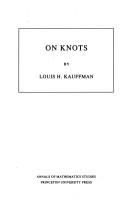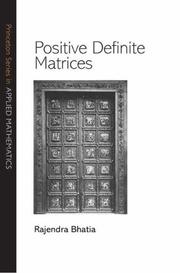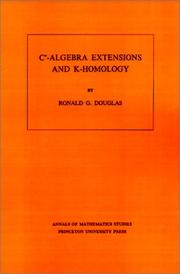| Listing 1 - 4 of 4 |
Sort by
|

ISBN: 0691084343 0691084351 1400882133 9780691084343 Year: 1987 Volume: 115 Publisher: Princeton (N.J.): Princeton university press,
Abstract | Keywords | Export | Availability | Bookmark
 Loading...
Loading...Choose an application
- Reference Manager
- EndNote
- RefWorks (Direct export to RefWorks)
On Knots is a journey through the theory of knots, starting from the simplest combinatorial ideas--ideas arising from the representation of weaving patterns. From this beginning, topological invariants are constructed directly: first linking numbers, then the Conway polynomial and skein theory. This paves the way for later discussion of the recently discovered Jones and generalized polynomials. The central chapter, Chapter Six, is a miscellany of topics and recreations. Here the reader will find the quaternions and the belt trick, a devilish rope trick, Alhambra mosaics, Fibonacci trees, the topology of DNA, and the author's geometric interpretation of the generalized Jones Polynomial.Then come branched covering spaces, the Alexander polynomial, signature theorems, the work of Casson and Gordon on slice knots, and a chapter on knots and algebraic singularities.The book concludes with an appendix about generalized polynomials.
Knot theory --- Knots (Topology) --- Low-dimensional topology --- Knot theory. --- Algebraic topology --- 3-sphere. --- Addition theorem. --- Addition. --- Alexander polynomial. --- Algebraic variety. --- Algorithm. --- Ambient isotopy. --- Arf invariant. --- Basepoint. --- Bijection. --- Bilinear form. --- Borromean rings. --- Bracket polynomial. --- Braid group. --- Branched covering. --- Chiral knot. --- Chromatic polynomial. --- Cobordism. --- Codimension. --- Combination. --- Combinatorics. --- Complex analysis. --- Concentric. --- Conjecture. --- Connected sum. --- Conway polynomial (finite fields). --- Counting. --- Covering space. --- Cyclic group. --- Dense set. --- Determinant. --- Diagram (category theory). --- Diffeomorphism. --- Dimension. --- Disjoint union. --- Disk (mathematics). --- Dual graph. --- Elementary algebra. --- Embedding. --- Enumeration. --- Existential quantification. --- Exotic sphere. --- Fibration. --- Formal power series. --- Fundamental group. --- Geometric topology. --- Geometry and topology. --- Geometry. --- Group action. --- Homotopy. --- Integer. --- Intersection form (4-manifold). --- Isolated singularity. --- Jones polynomial. --- Knot complement. --- Knot group. --- Laws of Form. --- Lens space. --- Linking number. --- Manifold. --- Module (mathematics). --- Morwen Thistlethwaite. --- Normal bundle. --- Notation. --- Obstruction theory. --- Operator algebra. --- Pairing. --- Parity (mathematics). --- Partition function (mathematics). --- Planar graph. --- Point at infinity. --- Polynomial ring. --- Polynomial. --- Quantity. --- Rectangle. --- Reidemeister move. --- Remainder. --- Root of unity. --- Saddle point. --- Seifert surface. --- Singularity theory. --- Slice knot. --- Special case. --- Statistical mechanics. --- Substructure. --- Summation. --- Symmetry. --- Theorem. --- Three-dimensional space (mathematics). --- Topological space. --- Torus knot. --- Trefoil knot. --- Tubular neighborhood. --- Underpinning. --- Unknot. --- Variable (mathematics). --- Whitehead link. --- Wild knot. --- Writhe. --- Variétés topologiques --- Topologie combinatoire --- Theorie des noeuds

ISBN: 1282129740 9786612129742 1400827787 9781400827787 9781282129740 0691129185 9780691129181 6612129743 Year: 2007 Publisher: Princeton, N.J. : Princeton University Press,
Abstract | Keywords | Export | Availability | Bookmark
 Loading...
Loading...Choose an application
- Reference Manager
- EndNote
- RefWorks (Direct export to RefWorks)
This book represents the first synthesis of the considerable body of new research into positive definite matrices. These matrices play the same role in noncommutative analysis as positive real numbers do in classical analysis. They have theoretical and computational uses across a broad spectrum of disciplines, including calculus, electrical engineering, statistics, physics, numerical analysis, quantum information theory, and geometry. Through detailed explanations and an authoritative and inspiring writing style, Rajendra Bhatia carefully develops general techniques that have wide applications in the study of such matrices. Bhatia introduces several key topics in functional analysis, operator theory, harmonic analysis, and differential geometry--all built around the central theme of positive definite matrices. He discusses positive and completely positive linear maps, and presents major theorems with simple and direct proofs. He examines matrix means and their applications, and shows how to use positive definite functions to derive operator inequalities that he and others proved in recent years. He guides the reader through the differential geometry of the manifold of positive definite matrices, and explains recent work on the geometric mean of several matrices. Positive Definite Matrices is an informative and useful reference book for mathematicians and other researchers and practitioners. The numerous exercises and notes at the end of each chapter also make it the ideal textbook for graduate-level courses.
Matrices. --- Algebra, Matrix --- Cracovians (Mathematics) --- Matrix algebra --- Matrixes (Algebra) --- Algebra, Abstract --- Algebra, Universal --- Matrices --- 512.64 --- 512.64 Linear and multilinear algebra. Matrix theory --- Linear and multilinear algebra. Matrix theory --- Addition. --- Analytic continuation. --- Arithmetic mean. --- Banach space. --- Binomial theorem. --- Block matrix. --- Bochner's theorem. --- Calculation. --- Cauchy matrix. --- Cauchy–Schwarz inequality. --- Characteristic polynomial. --- Coefficient. --- Commutative property. --- Compact space. --- Completely positive map. --- Complex number. --- Computation. --- Continuous function. --- Convex combination. --- Convex function. --- Convex set. --- Corollary. --- Density matrix. --- Diagonal matrix. --- Differential geometry. --- Eigenvalues and eigenvectors. --- Equation. --- Equivalence relation. --- Existential quantification. --- Extreme point. --- Fourier transform. --- Functional analysis. --- Fundamental theorem. --- G. H. Hardy. --- Gamma function. --- Geometric mean. --- Geometry. --- Hadamard product (matrices). --- Hahn–Banach theorem. --- Harmonic analysis. --- Hermitian matrix. --- Hilbert space. --- Hyperbolic function. --- Infimum and supremum. --- Infinite divisibility (probability). --- Invertible matrix. --- Lecture. --- Linear algebra. --- Linear map. --- Logarithm. --- Logarithmic mean. --- Mathematics. --- Matrix (mathematics). --- Matrix analysis. --- Matrix unit. --- Metric space. --- Monotonic function. --- Natural number. --- Open set. --- Operator algebra. --- Operator system. --- Orthonormal basis. --- Partial trace. --- Positive definiteness. --- Positive element. --- Positive map. --- Positive semidefinite. --- Positive-definite function. --- Positive-definite matrix. --- Probability measure. --- Probability. --- Projection (linear algebra). --- Quantity. --- Quantum computing. --- Quantum information. --- Quantum statistical mechanics. --- Real number. --- Riccati equation. --- Riemannian geometry. --- Riemannian manifold. --- Riesz representation theorem. --- Right half-plane. --- Schur complement. --- Schur's theorem. --- Scientific notation. --- Self-adjoint operator. --- Sign (mathematics). --- Special case. --- Spectral theorem. --- Square root. --- Standard basis. --- Summation. --- Tensor product. --- Theorem. --- Toeplitz matrix. --- Unit vector. --- Unitary matrix. --- Unitary operator. --- Upper half-plane. --- Variable (mathematics).
Book
ISBN: 1400865255 9781400865253 Year: 2006 Publisher: Princeton, New Jersey ; Oxfordshire, England : Princeton University Press,
Abstract | Keywords | Export | Availability | Bookmark
 Loading...
Loading...Choose an application
- Reference Manager
- EndNote
- RefWorks (Direct export to RefWorks)
Diffusive motion--displacement due to the cumulative effect of irregular fluctuations--has been a fundamental concept in mathematics and physics since Einstein's work on Brownian motion. It is also relevant to understanding various aspects of quantum theory. This book explains diffusive motion and its relation to both nonrelativistic quantum theory and quantum field theory. It shows how diffusive motion concepts lead to a radical reexamination of the structure of mathematical analysis. The book's inspiration is Princeton University mathematics professor Edward Nelson's influential work in probability, functional analysis, nonstandard analysis, stochastic mechanics, and logic. The book can be used as a tutorial or reference, or read for pleasure by anyone interested in the role of mathematics in science. Because of the application of diffusive motion to quantum theory, it will interest physicists as well as mathematicians. The introductory chapter describes the interrelationships between the various themes, many of which were first brought to light by Edward Nelson. In his writing and conversation, Nelson has always emphasized and relished the human aspect of mathematical endeavor. In his intellectual world, there is no sharp boundary between the mathematical, the cultural, and the spiritual. It is fitting that the final chapter provides a mathematical perspective on musical theory, one that reveals an unexpected connection with some of the book's main themes.
Mathematical physics. --- Diffusion. --- Quantum theory. --- Quantum dynamics --- Quantum mechanics --- Quantum physics --- Physics --- Mechanics --- Thermodynamics --- Gases --- Liquids --- Separation (Technology) --- Solution (Chemistry) --- Solutions, Solid --- Matter --- Packed towers --- Semiconductor doping --- Physical mathematics --- Diffusion --- Properties --- Mathematics --- Affine space. --- Algebra. --- Axiom. --- Bell's theorem. --- Brownian motion. --- Central limit theorem. --- Classical mathematics. --- Classical mechanics. --- Clifford algebra. --- Combinatorial proof. --- Commutative property. --- Constructive quantum field theory. --- Continuum hypothesis. --- David Hilbert. --- Dimension (vector space). --- Discrete mathematics. --- Distribution (mathematics). --- Eigenfunction. --- Equation. --- Euclidean space. --- Experimental mathematics. --- Fermi–Dirac statistics. --- Feynman–Kac formula. --- First-order logic. --- Fokker–Planck equation. --- Foundations of mathematics. --- Fractal dimension. --- Gaussian process. --- Girsanov theorem. --- Gödel's incompleteness theorems. --- Hilbert space. --- Hilbert's program. --- Holomorphic function. --- Infinitesimal. --- Integer. --- Internal set theory. --- Interval (mathematics). --- Limit (mathematics). --- Mathematical induction. --- Mathematical optimization. --- Mathematical proof. --- Mathematician. --- Mathematics. --- Measurable function. --- Measure (mathematics). --- Minkowski space. --- Natural number. --- Neo-Riemannian theory. --- Non-standard analysis. --- Number theory. --- Operator algebra. --- Ornstein–Uhlenbeck process. --- Orthonormal basis. --- Perturbation theory (quantum mechanics). --- Philosophy of mathematics. --- Predicate (mathematical logic). --- Probability measure. --- Probability space. --- Probability theory. --- Probability. --- Projection (linear algebra). --- Pure mathematics. --- Pythagorean theorem. --- Quantum field theory. --- Quantum fluctuation. --- Quantum gravity. --- Quantum harmonic oscillator. --- Quantum mechanics. --- Quantum system. --- Quantum teleportation. --- Random variable. --- Real number. --- Renormalization group. --- Renormalization. --- Riemann mapping theorem. --- Riemann surface. --- Riemannian geometry. --- Riemannian manifold. --- Schrödinger equation. --- Scientific notation. --- Set (mathematics). --- Sign (mathematics). --- Sobolev inequality. --- Special relativity. --- Spectral theorem. --- Spin (physics). --- Statistical mechanics. --- Stochastic calculus. --- Stochastic differential equation. --- Tensor algebra. --- Theorem. --- Theoretical physics. --- Theory. --- Turing machine. --- Variable (mathematics). --- Von Neumann algebra. --- Wiener process. --- Wightman axioms. --- Zermelo–Fraenkel set theory.

ISBN: 0691082650 0691082669 1400881463 Year: 1980 Publisher: Princeton, N.J.
Abstract | Keywords | Export | Availability | Bookmark
 Loading...
Loading...Choose an application
- Reference Manager
- EndNote
- RefWorks (Direct export to RefWorks)
Recent developments in diverse areas of mathematics suggest the study of a certain class of extensions of C*-algebras. Here, Ronald Douglas uses methods from homological algebra to study this collection of extensions. He first shows that equivalence classes of the extensions of the compact metrizable space X form an abelian group Ext (X). Second, he shows that the correspondence X ⃗ Ext (X) defines a homotopy invariant covariant functor which can then be used to define a generalized homology theory. Establishing the periodicity of order two, the author shows, following Atiyah, that a concrete realization of K-homology is obtained.
Analytical spaces --- 517.986 --- Topological algebras. Theory of infinite-dimensional representations --- Algebra, Homological. --- C*-algebras. --- K-theory. --- 517.986 Topological algebras. Theory of infinite-dimensional representations --- Algebra, Homological --- C*-algebras --- K-theory --- Algebraic topology --- Homology theory --- Algebras, C star --- Algebras, W star --- C star algebras --- W star algebras --- W*-algebras --- Banach algebras --- Homological algebra --- Algebra, Abstract --- K-théorie. --- Homologie. --- Addition. --- Affine transformation. --- Algebraic topology. --- Atiyah–Singer index theorem. --- Automorphism. --- Banach algebra. --- Bijection. --- Boundary value problem. --- Bundle map. --- C*-algebra. --- Calculation. --- Cardinal number. --- Category of abelian groups. --- Characteristic class. --- Chern class. --- Clifford algebra. --- Coefficient. --- Cohomology. --- Compact operator. --- Completely positive map. --- Contact geometry. --- Continuous function. --- Corollary. --- Diagram (category theory). --- Diffeomorphism. --- Differentiable manifold. --- Differential operator. --- Dimension (vector space). --- Dimension function. --- Dimension. --- Direct integral. --- Direct proof. --- Eigenvalues and eigenvectors. --- Equivalence class. --- Equivalence relation. --- Essential spectrum. --- Euler class. --- Exact sequence. --- Existential quantification. --- Fiber bundle. --- Finite group. --- Fredholm operator. --- Fredholm. --- Free abelian group. --- Fundamental class. --- Fundamental group. --- Hardy space. --- Hermann Weyl. --- Hilbert space. --- Homological algebra. --- Homology (mathematics). --- Homomorphism. --- Homotopy. --- Ideal (ring theory). --- Inner automorphism. --- Irreducible representation. --- K-group. --- Lebesgue space. --- Locally compact group. --- Maximal compact subgroup. --- Michael Atiyah. --- Monomorphism. --- Morphism. --- Natural number. --- Natural transformation. --- Normal operator. --- Operator algebra. --- Operator norm. --- Operator theory. --- Orthogonal group. --- Pairing. --- Piecewise linear manifold. --- Polynomial. --- Pontryagin class. --- Positive and negative parts. --- Positive map. --- Pseudo-differential operator. --- Quaternion. --- Quotient algebra. --- Self-adjoint operator. --- Self-adjoint. --- Simply connected space. --- Smooth structure. --- Special case. --- Stein manifold. --- Strong topology. --- Subalgebra. --- Subgroup. --- Subset. --- Summation. --- Tangent bundle. --- Theorem. --- Todd class. --- Topology. --- Torsion subgroup. --- Unitary operator. --- Universal coefficient theorem. --- Variable (mathematics). --- Von Neumann algebra. --- Homology theory. --- Homologie --- K-théorie --- C etoile-algebres
| Listing 1 - 4 of 4 |
Sort by
|

 Search
Search Feedback
Feedback About UniCat
About UniCat  Help
Help News
News